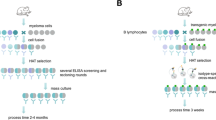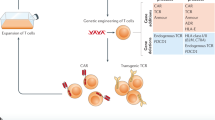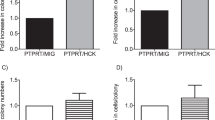Abstract
CELL FUSION has been used to study problems in genetics, neoplasia and virology1. Its application to immunology was initiated by the experiments of Köhler and Milstein2, in which it was shown that a myeloma cell (a neoplastic B cell) could be fused with a normal antibody-producing B cell, and that the hybrids continued to secrete the specific antibody of the latter and grew as permanent lines. This type of fusion has since been used to produce homogeneous antibodies to a variety of antigens3,4. The same principle can also be applied to T cells, with the aim of producing T-hybrid lines with characteristic T-cell functions, such as cytotoxicity or the ability to help or suppress the responses of other lymphocytes. Recently, fusion of T cells with T-lymphoma cells has been described, leading to the establishment of lines carrying markers characteristic of the normal T-cell partner5–7, and some lines with T-cell activities have been reported8,9. We describe here the production of a hybrid line which exhibits a characteristic T-cell function, namely, specific suppression of the antibody response. The hybrid cells produce a suppressor molecule or ‘factor’ which binds to an antigen, sheep red blood cells (SRBC), and specifically suppresses the antibody response to this antigen in vitro. The factor is non-immunoglobulin, but carries determinants of the H–2 complex.
This is a preview of subscription content, access via your institution
Access options
Subscribe to this journal
Receive 51 print issues and online access
$199.00 per year
only $3.90 per issue
Buy this article
- Purchase on Springer Link
- Instant access to full article PDF
Prices may be subject to local taxes which are calculated during checkout
Similar content being viewed by others
References
Ringerts, N. R. & Savage, R. E. Cell Hybrids (Academic, New York, 1976).
Köhler, G. & Milstein, C. Nature 256,495–497 (1975).
Galfré, G., Howe, S. C., Milstein, C., Butcher, G. W. & Howard, J. C. Nature 266, 550–552 (1977).
Lemke, H., Hämmerling, G. J., Höhmann, C. & Rajewsky, K. Nature 271, 251–253 (1978).
Goldsby, R. A., Osborne, B. A., Simpson, E. & Herzenberg, L. A. Nature 267, 707–708 (1977).
Hämmerling, G. J. Eur. J. Immun. 7, 743–746 (1977).
Köhler, G., Lefkovits, I., Elliot, B. & Coutinho, A. Eur. J. Immun. 7, 758–761 (1977).
Kontiainen, S. et al. Nature 274, 477–480 (1978).
Tainguchi, M. & Miller, J. F. A. P. J. exp. Med. 148, 373–381 (1978).
Littlefield, J. W. Science 145, 709–710 (1964).
Pontecorvo, G. Somatic Cell Genetics 1, 397–400 (1975).
Corval´n, J. R. F. & Howard, J. C. (in preparation).
Taussig, M. J. & Holliman, A. Nature 277, 308–310 (1979).
Taussig, M. J. and Binns, R. M. (in preparation).
Taussig, M. J. & Munro, A. J. Nature 251, 64–65 (1974).
Tada, T., Taniguchi, M. & David, C. S. Cold Spring Harb. Symp. quant. Biol. 41, 119–128 (1977).
Taussig, M. J. et al., (in preparation).
Gisler, R. H. & Fridman, W. H. J. exp. Med. 142, 507–511 (1975).
Cunningham, A. J. & Szenberg, A. Immunology 14, 599–601 (1968).
Sprent, J. Cell. Immun. 7, 10–39 (1973).
Rittenberg, M. B. & Pratt, K. L. Proc. Soc. exp. Biol. Med. 132, 575–581 (1969).
Author information
Authors and Affiliations
Rights and permissions
About this article
Cite this article
TAUSSIG, M., CORVALÁN, J., BINNS, R. et al. Production of an H–2-related suppressor factor by a hybrid T-cell line. Nature 277, 305–308 (1979). https://doi.org/10.1038/277305a0
Received:
Accepted:
Issue Date:
DOI: https://doi.org/10.1038/277305a0
This article is cited by
-
BW5147 and Derivatives for the Study of T Cells and their Antigen Receptors
Archivum Immunologiae et Therapiae Experimentalis (2020)
-
Interspecies somatic T cell hybrids as biological tools for studying gene expression during T cell development
International Journal of Clinical & Laboratory Research (1994)
Comments
By submitting a comment you agree to abide by our Terms and Community Guidelines. If you find something abusive or that does not comply with our terms or guidelines please flag it as inappropriate.



